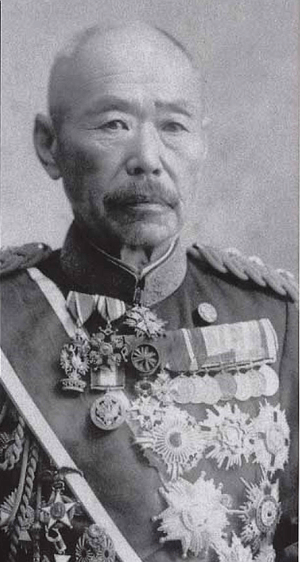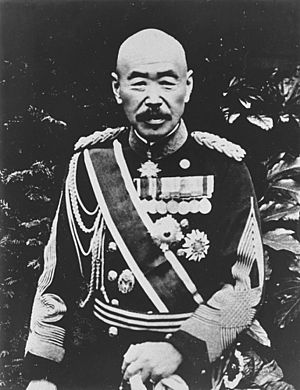Uehara Yūsaku facts for kids
Quick facts for kids
Uehara Yūsaku
|
|
|---|---|
|
上原 勇作
|
|

General Viscount Uehara Yūsaku
|
|
| 9th Army Minister | |
| In office April 5, 1912 – December 21, 1912 |
|
| Monarch | Meiji Taishō |
| Preceded by | Ishimoto Shinroku |
| Succeeded by | Kigoshi Yasutsuna |
| Chief of the Imperial Japanese Army General Staff | |
| In office December 17, 1915 – March 17, 1923 |
|
| Monarch | Taishō |
| Preceded by | Hasegawa Yoshimichi |
| Succeeded by | Kawai Misao |
| Personal details | |
| Born | December 6, 1856 Miyakonojō, Hyūga, Japan |
| Died | November 8, 1933 (aged 76) Tokyo, Japan |
| Military service | |
| Allegiance | Empire of Japan |
| Branch/service | |
| Years of service | 1879–1933 |
| Rank | |
| Battles/wars | Russo-Japanese War |
Viscount Uehara Yūsaku (上原 勇作, 6 December 1856 – 8 November 1933) was a very important military leader in Japan. He became a Field Marshal, which is the highest rank in the Imperial Japanese Army. He was also the person who started the Imperial Japanese Army Engineering Corps, a special part of the army that focuses on building and technology. His wife was the daughter of another famous general, Nozu Michitsura.
Biography
Early Life and Career
Uehara Yūsaku was born in 1856 in a place called Miyakonojō, which is now part of Miyazaki Prefecture. His birth name was Tatsuoka Shinaga. He came from a family of samurai, who were traditional Japanese warriors.
In 1875, he was adopted by the Uehara family and changed his name to Uehara Yūsaku. He went to the Imperial Japanese Army Academy, a special school for army officers, and graduated in 1879. He studied military engineering, which means he learned how to design and build things for the army, like forts.
In 1881, Uehara went to France to learn more about modern military techniques. He studied things like how to build strong defenses and use artillery (big guns). While in France, he was promoted to lieutenant and then captain.
After returning to Japan in 1885, he worked in important offices within the Imperial Japanese Army General Staff, which is like the army's main planning department. He also served as a military attaché in Europe, meaning he was a military expert sent to represent Japan in other countries.
He was promoted to major in 1890 and worked with the IJA 5th Division, which was led by his father-in-law, General Nozu Michitsura. Uehara was known for being very smart and became part of a special group of advisors.
Uehara also worked as an aide-de-camp (a personal assistant) for Prince Arisugawa Taruhito and taught at the Army Staff College. He traveled to different countries like Annam (now part of Vietnam), Thailand, and Korea as a military expert.
During the First Sino-Japanese War, which started in 1894, Uehara was part of the Japanese First Army. He was promoted to lieutenant colonel and later became the chief-of-staff for the First Army. A chief-of-staff is a senior leader who helps the main commander with planning and operations.
In 1896, he went to Russia as part of Japan's official group for the coronation of Tsar Nicholas II. After returning, he was promoted to colonel. In 1899, he was Japan's representative at the Hague Convention, an international meeting about the rules of war.
Becoming a General
In 1900, Uehara was promoted to major general. He also became the head of the Army Artillery School. Before the Russo-Japanese War began in 1904, he was sent to Europe again as a military attaché.
During the Russo-Japanese War, Uehara became the chief-of-staff for the Japanese Fourth Army. He was known for being one of the few people who could work well with General Nozu, his father-in-law, who was known to be difficult.
In 1906, he was promoted to lieutenant general. The next year, he was given the title of baron (danshaku), which is a noble title in Japan. In 1908, he became the commander of the IJA 7th Division. This was a big deal because it was the first time an engineering officer was put in charge of a whole army division.
In 1912, Uehara became the Army Minister in the government. This meant he was in charge of the entire army department. However, he disagreed with the government about money for the army. He wanted more funding for new army divisions, but the government wanted to save money.
Because of this disagreement, Uehara resigned as Army Minister. When he resigned, the army refused to name a replacement, which caused the entire government to fall apart. This event is known as the "Taisho Political Crisis."
After this, Uehara continued to serve in important army roles. In 1914, he became the Inspector General of Military Training, which was a very important job in charge of how the army trained. In 1915, he was promoted to general. He also became the Chief of the Imperial Japanese Army General Staff, which meant he was the top military leader in charge of all army plans. He held this position for a very long time.
While he was Chief of the General Staff, he approved the Siberian Intervention. This was when Japan sent troops to Russia to help one side (the White Army) during the Russian Civil War against another group (the Bolshevik Red Army).
In 1921, Uehara was given the highest military rank of Marshal. His noble title was also raised to shishaku (viscount). He retired soon after and became the president of the Kaikosha association, a group for retired military veterans.
Uehara Yūsaku passed away in 1933 in Tokyo at the age of 77. He was buried at the Aoyama Cemetery in Tokyo.
Decorations
Uehara Yūsaku received many awards and honors for his long and distinguished service to Japan:
- 1893 –
 Order of the Sacred Treasure, 6th class
Order of the Sacred Treasure, 6th class - 1895 –
 Order of the Rising Sun, 5th class
Order of the Rising Sun, 5th class - 1895 –
 Order of the Golden Kite, 4th class
Order of the Golden Kite, 4th class - 1896 –
 Order of the Sacred Treasure, 5th class
Order of the Sacred Treasure, 5th class - 1899 –
 Order of the Rising Sun, 4th class
Order of the Rising Sun, 4th class - 1901 –
 Order of the Rising Sun, 2nd class
Order of the Rising Sun, 2nd class - 1906 –
 Order of the Golden Kite, 2nd class
Order of the Golden Kite, 2nd class - 1908 –
 Grand Cordon of the Order of the Sacred Treasure
Grand Cordon of the Order of the Sacred Treasure - 1915 –
 Grand Cordon of the Order of the Rising Sun
Grand Cordon of the Order of the Rising Sun - 1920 –
 Order of the Rising Sun with Paulownia Flowers
Order of the Rising Sun with Paulownia Flowers - 1933 –
 Grand Cordon of the Supreme Order of the Chrysanthemum (awarded after his death)
Grand Cordon of the Supreme Order of the Chrysanthemum (awarded after his death)


